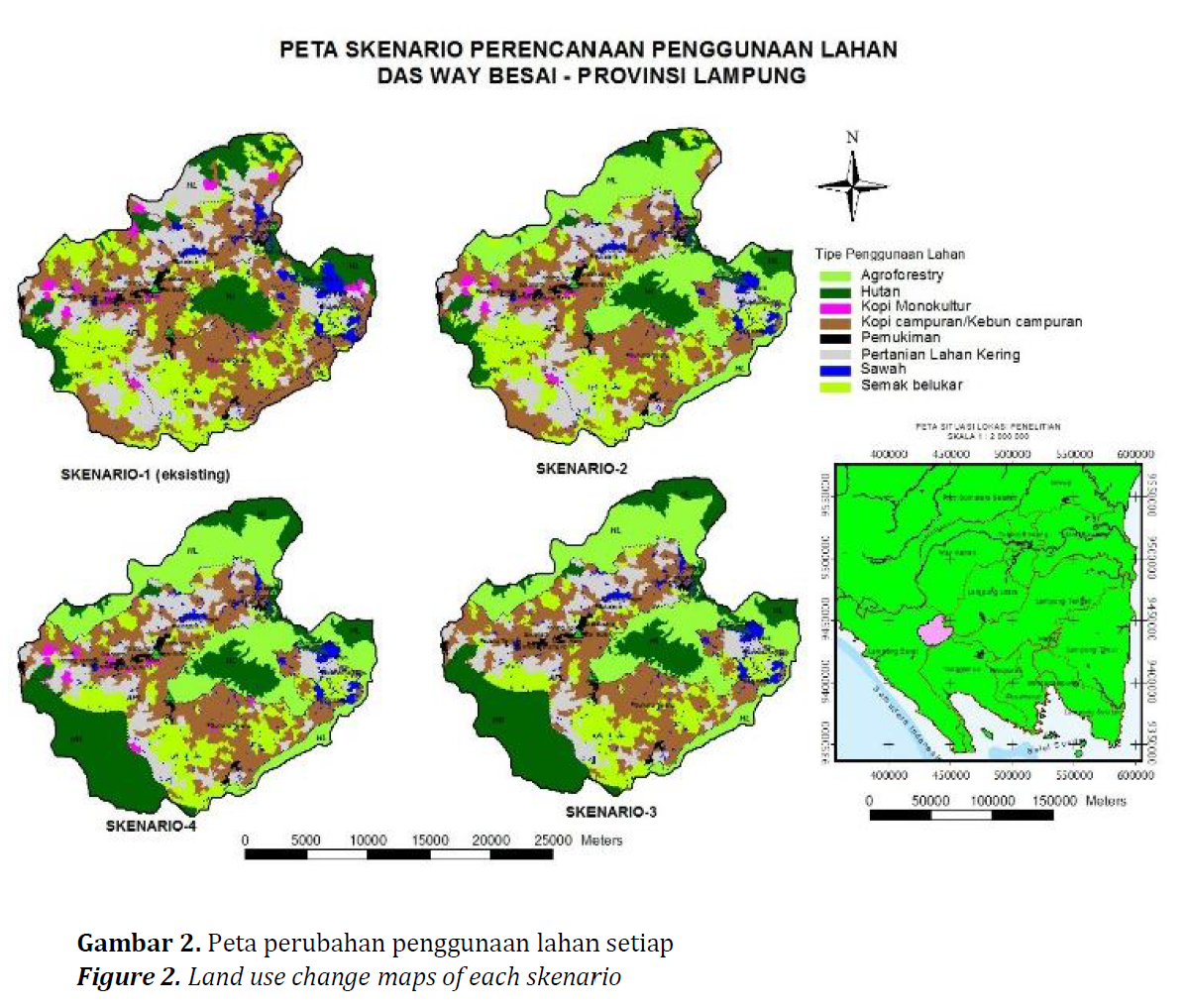Perencaaan Penggunaan Lahan Dan Pengaruhnya Terhadap Sumberdaya Air Di DAS Way Besai-Lampung

The problems on water resource are the decreasing of water supply due to the impact of land use changes. The population growth and the rising economy activity lead to the increasing of water demands. Way Besai area of 44,720 hectares has an important role in the provision of water resources. The aims of this research are: to assess the water supply and demand, to assess the water balance and, to formulate the best recommendation of land management planning. This research was conducted in 2011. The SCS (Soil Conservation Service) model was applied to determine land use planning scenarios and run-off prediction. The result shows that the water demand in Way Besai Watershed is 441,450,909m3/year, while water supply is 460,452,600 m3/year. Application of community forestry by applying agroforestry system, implementation of forest rehabilitation on area outside HKm permit, and conducting the change for coffee monoculture to mixed coffee crop in the area outside the forest is considered the best scenario of land management for Way Besai watershed. This scenario could produce 1,055.79 mm/years run-off, coefficient total runoff is 38.52%, water supply is 472,147,141 m3/years, storage is 7,911,616 m3/years and, can meet the of water demand in the dry months at 58.48%.
Arsyad, S. (2010). Konservasi Tanah dan Air. Bogor: IPB Press.
[BPS] Badan Pusat Statistik. (2012). Kabupaten Lampung Barat Dalam Angka 2012. Liwa: BPS Kabupaten Lampung Barat.
Budidarsono, S, dan Wijaya, K. (2004). Praktek konservasi dalam budidaya kopi robusta dan keuntungan petani. Jurnal Agrivita, 26(1), 107-118.
[Dephut] Departemen Kehutanan. (2007). SK Menhutbun No.256/Kpts-II/2000. Luas Hutan di Provinsi Lampung. Bandar Lampung.
[Dephut] Departemen Kehutanan. (2007). P.37/Menhut-II/2007 tentang Hutan Kemasyarakatan. Dirjen RLPS. Jakarta.
[Dephut] Departemen Kehutanan. (2009). Peraturan Dirjen RLPS No.P.04/V-SET/2009 tentang Pedoman Monitoring dan Evaluasi Daerah Aliran Sungai. Dirjen RLPS. Jakarta.
Ferijal, T. (2012). Prediksi Hasil Limpasan Permukaan dan Laju Erosi Dari Sub DAS Krueng Jreu Menggunakan Model SWAT. Jurnal Agrivita, 16(1), 29-38.
Halidah. (2008). Potensi dan Distribusi Air Hutan Lindung Provinsi Gorontalo. Jurnal Penelitian Hutan dan Konservasi Alam, 5 (1), 43-53.
Harsoyo, B. (2010). Review Modeling Hidrologi DAS di Indonesia. Jurnal Sains dan Teknologi Modifikasi Cuaca, 11(1), 41-47.
Hatmoko, W, Radhika, Amirwandi, S, Herwindo, W, dan Fauzi, M. (2012). Ketersediaan Air Permukaan Pada Wilayah Sungai di Indonesia. Jakarta: Puslitbang Sumber Daya Air.
Indarto. (2010). Hidrologi Dasar Teori dan Contoh Aplikasi Model Hidrologi. Jakarta: Bumi Aksara.
Junaidi, E. (2009). Kajian berbagai alternative perencanaan pengelolaan DAS Cisadane menggunakan model SWAT. [Thesis]. Sekolah Pascasarjana Institut Pertanian Bogor.
Latifah, I. (2013). Analisis Ketersediaan Air, Sedimentasi, dan Karbon Organik Dengan Model SWAT di Hulu DAS Jeneberang Sulawesi Selatan. [Thesis]. Sekolah Pascasarjana Institut Pertanian Bogor.
McQueen, and Richarcd, H. (1982). A Guide to hidrologic Analysis Using SCS Methodes. USA: Prentice Hall Inc.
Nash, J.E., and Sutcliffe, J.V. (1970). River Flow Forecasting Through Conceptual Models Part IDiscussion of Principles. Journal of Hydrologi, 10 (3), 282-190.
Notohadiprawiro. (2006). Rasionalisasi Penggunaan Sumberdaya Air di Indonesia. Universitas Gadjah Mada.[internet].[diunduh 2013 Des 13]. Tersedia pada: http:/www.soil.faperta.ugm. ac.id/ tj/19XX/19xx%20RASIONALISASI.pdf
Nursidah. (2012). Pengembangan Institusi Untuk Membangun Kemandirian Dalam Pengelolaan Daerah Aliran Sungai Terpadu (Studi Kasus padamSatuan Wilayah Pengelolaan Daerah Aliran SungaimArau Sumatera Barat). [Disertasi]. Sekolah Pascasarjana Institut Pertanian Bogor.
Purbawa, Gede, A., dan Nyoman, G.W. (2009). Analisis Spasial Normal Ketersediaan Air Tanah Bulanan di Provinsi Bali. Buletin Meteorologi Klimatologi dan Geofisika, 5 (2), 150-159.
Ria, J. (2008). Identifikasi aliran permukaan di setiap kecamatan DKI Jakarta menggunakan metode SCS. [Skripsi]. IPB. Bogor.
Sihite, J.H.S. (2001). Valuasi Ekonomi dari Perubahan Penggunaan Lahan di Sub DAS Besai-DAS Tulang Bawang Lampung [Thesis]. Sekolah Pascasarjana Institut Pertanian Bogor.
Soeharto, B. (2010). Nilai Air dan Manfaaf Bagi Masyarakat serta PLTA Way Besai pada beberapa Skenario Perubahan Penggunaan Lahan di Kecamatan Sumber Jaya Kabupaten Lampung Barat Provinsi Lampung [Disertasi].Sekolah Pascasarjana Institut Pertanian Bogor.
Triadmojo, B. (2009). Hidrologi Terapan. Yogyakarta: Gadjahmada University Press.
Yuwono, S.B. (2011). Pengembangan Sumberdaya Air Berkelanjutan DAS Way Betung Kota Bandar Lampung [Disertasi].

